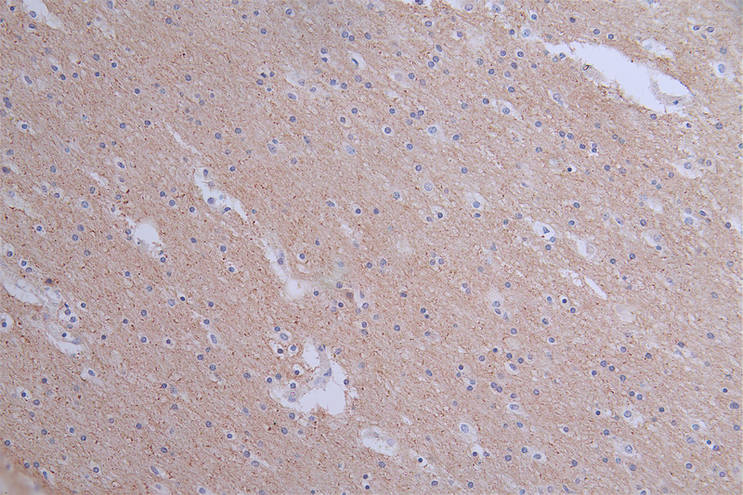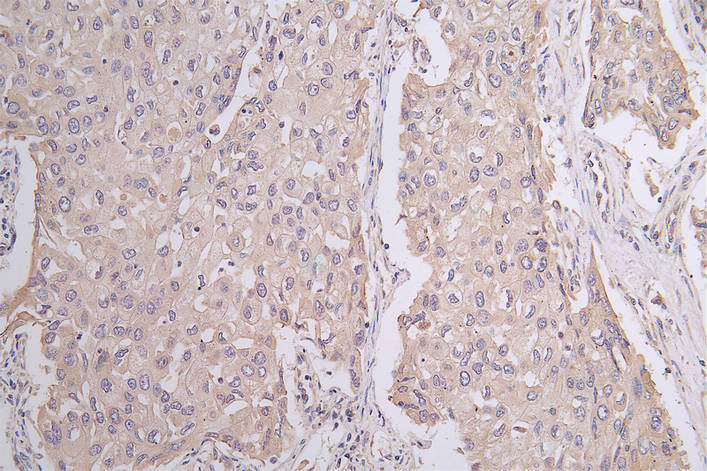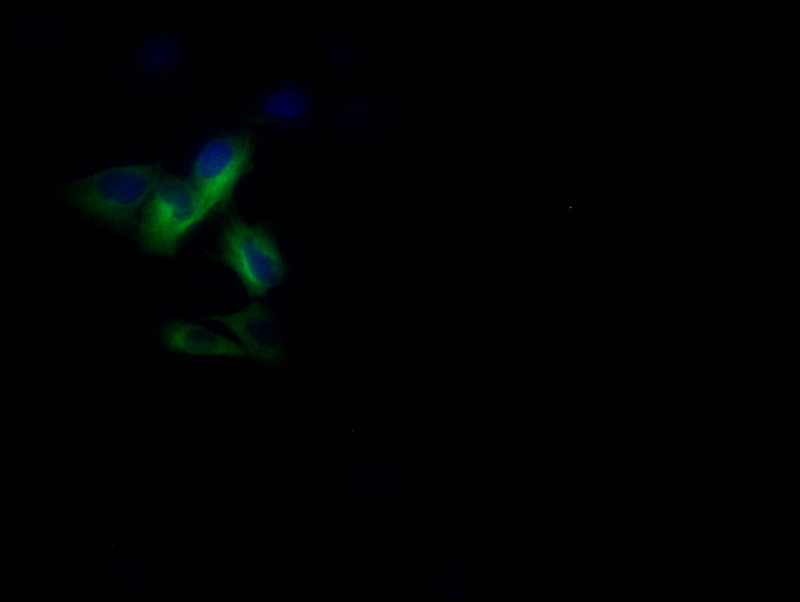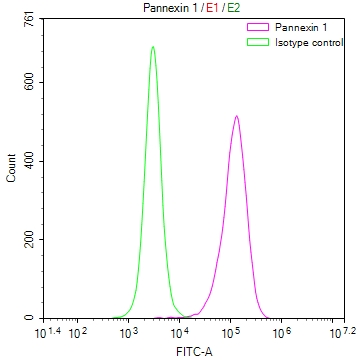PANX1 Recombinant Monoclonal Antibody
-
货号:CSB-RA549607A0HU
-
规格:¥1320
-
图片:
-
IHC image of CSB-RA549607A0HU diluted at 1:50 and staining in paraffin-embedded human brain tissue performed on a Leica BondTM system. After dewaxing and hydration, antigen retrieval was mediated by high pressure in a citrate buffer (pH 6.0). Section was blocked with 10% normal goat serum 30min at RT. Then primary antibody (1% BSA) was incubated at 4°C overnight. The primary is detected by a Goat anti-rabbit polymer IgG labeled by HRP and visualized using 0.1:50% DAB.
-
IHC image of CSB-RA549607A0HU diluted at 1:50 and staining in paraffin-embedded human lung cancer performed on a Leica BondTM system. After dewaxing and hydration, antigen retrieval was mediated by high pressure in a citrate buffer (pH 6.0). Section was blocked with 10% normal goat serum 30min at RT. Then primary antibody (1% BSA) was incubated at 4°C overnight. The primary is detected by a Goat anti-rabbit polymer IgG labeled by HRP and visualized using 0.1:50% DAB.
-
Immunofluorescence staining of U251 with CSB-RA549607A0HU at 1:10, counter-stained with DAPI. The cells were fixed in 4% formaldehyde and blocked in 10% normal Goat Serum. The cells were then incubated with the antibody overnight at 4°C. The secondary antibody was Alexa Fluor 502-congugated AffiniPure Goat Anti-Rabbit IgG(H+L).
-
Overlay Peak curve showing A549 cells surface stained with CSB-RA549607A0HU (red line) at 1:50. Then 10% normal goat serum to block non-specific protein-protein interactions followed by the antibody (1µg/1*106cells) for 45min at 4℃. The secondary antibody used was FITC-conjugated Goat Anti-rabbit IgG(H+L) at 1:200 dilution for 35min at 4℃.Control antibody (green line) was rabbit IgG (1µg/1*106cells) used under the same conditions. Acquisition of >10,000 events was performed.
-
-
其他:
产品详情
-
Uniprot No.:Q96RD7
-
基因名:
-
别名:Pannexin-1, PANX1, MRS1
-
反应种属:Human
-
免疫原:A synthesized peptide derived from Human PANX1
-
免疫原种属:Homo sapiens (Human)
-
标记方式:Non-conjugated
-
克隆类型:Monoclonal
-
抗体亚型:Rabbit IgG
-
纯化方式:Affinity-chromatography
-
克隆号:28G5
-
浓度:It differs from different batches. Please contact us to confirm it.
-
保存缓冲液:Rabbit IgG in phosphate buffered saline, pH 7.4, 150mM NaCl, 0.02% sodium azide and 50% glycerol.
-
产品提供形式:Liquid
-
应用范围:ELISA, IHC, IF, FC
-
推荐稀释比:
Application Recommended Dilution IHC 1:50-1:200 IF 1:50-1:200 FC 1:50-1:200 -
Protocols:
-
储存条件:Upon receipt, store at -20°C or -80°C. Avoid repeated freeze.
-
货期:Basically, we can dispatch the products out in 1-3 working days after receiving your orders. Delivery time maybe differs from different purchasing way or location, please kindly consult your local distributors for specific delivery time.
相关产品
靶点详情
-
功能:Structural component of the gap junctions and the hemichannels involved in the ATP release and nucleotide permeation. May play a role as a Ca(2+)-leak channel to regulate ER Ca(2+) homeostasis. Plays a critical role in oogenesis.
-
基因功能参考文献:
- Progressive PANX1 channel opening is directly linked to permeation of ions and large and occurs during both irreversible and reversible forms of channel activation. This unique, quantized activation process enables fine tuning of PANX1 channel activity and may be a generalized regulatory mechanism for other related multimeric channels. PMID: 28134257
- s proposed a tentative intracellular signaling pathway of the acetylcholine-induced ciliary beat, in which the pannexin-1-purinergic P2X receptor unit may play a central role in ciliary beat regulation PMID: 29676177
- These results newly identify Pannexin-1 as a protein highly expressed in human dermal lymphatic endothelial cells. PMID: 29882918
- The pannexin 2 (Panx2) N86Q mutant is glycosylation-deficient and tends to aggregate in the endoplasmic reticulum (ER)reducing its cell surface trafficking but it can still interact with pannexin 1 (Panx1). PMID: 29932112
- All three pannexins Panx1, Panx2, and Panx3 mRNAs were expressed in all of the analyzed undifferentiated stem cell lines. PMID: 29357945
- These results elucidate for the first time PNX1-hemichannels as potentially main extracellular translocation pathway for NDKs from an intracellular pathogen. PMID: 27883084
- Pannexin1 (Panx1) was suggested to be functionally associated with purinergic P2X and N-methyl-D-aspartate (NMDA) receptor channels. Activation of these receptor channels by their endogenous ligands leads to cross-activation of Panx1 channels. This in turn potentiates P2X and NMDA receptor channel signaling. PMID: 28389204
- The ubiquitous expression, as well as its function as a major ATP release and nucleotide permeation channel, makes Panx1 a primary candidate for participating in the pathophysiology of CNS disorders. PMID: 28735901
- Panx1 was mainly distributed in microcolumn neurons, dysmorphic neurons, balloon cells and reactive astrocytes in cortical lesions from intractable epilepsy patients with focal cortical dysplasia. PMID: 28036289
- ATP release from red blood cells is not mediated by the cAMP-mediated Panx1 pathway. PMID: 28855161
- Panx1 channels are involved in beta-toxin-induced cell death. PMID: 27720686
- Pannexin1 is a mediator of inflammation and cell death. (Review) PMID: 27741412
- Panx1 channels promote skeletal muscle myoblast differentiation and fusion. (Review) PMID: 27518505
- presence of the Panx1-400C allele was not associated with platelet reactivity in stable cardiovascular patients. PMID: 28142297
- Overactive Panx-1 promotes cancer cell survival in the context of mechanical deformation. Panx-1 inhibitors can be used to treat highly metastatic cancer. Mechanosensitive Panx-1 channels will be a new target for the prevention of metastasis and stress-induced diseases. PMID: 27025600
- The results of this study do not support a major contribution of PANX1-3 to disease risk of schizophrenia according to DSM-5. PMID: 26223428
- a pivotal role of P2X7 receptor-pannexin-1 in oxysterols toxicity in retinal cells PMID: 27109381
- Data indicate that the consanguineous parents are each heterozygous for Pannexin1 (PANX1) but are not affected by the multiorgan syndromes. PMID: 27129271
- CBX and other inhibitors, including probenecid, attenuate Panx1 channel activity through modulation of the first extracellular loop. PMID: 26755773
- Decreased Panx1 function is a response to cell acidification mediated by IFN-gamma-induced up-regulation of Duox2. PMID: 26823467
- PANX-1 plays an important role in the release of cytokines and glutamate in a tumor cell line. PMID: 26385361
- The frequency of Panx1-400C homozygotes was higher among cardiovascular patients with hyper-reactive platelets. The Panx1-400C variant encodes a gain-of-function channel that enhances collagen-induced ATP release and platelet aggregation. PMID: 25947940
- Pannexin1-dependent pathophysiological eATP release in lipoapoptosis is capable of stimulating migration of human monocytes PMID: 26054298
- Panx1 channels promote leukocyte adhesion and emigration through the venous wall during acute systemic inflammation. PMID: 26242575
- This review focuses on the known roles of Panx1 related to purinergic signalling in the vasculature focusing on post-translational modifications and channel gating mechanisms that may participate in the regulated release of ATP. PMID: 26009197
- Within this review, the regulation of Panx1 channels is discussed, with a focus on how they may contribute to platelet function. PMID: 26009198
- These findings indicate that Panx1 participates in urothelial mechanotransduction and signaling by providing a direct pathway for mechanically-induced ATP release and by functionally interacting with P2X7Rs PMID: 25170954
- Data show that mutation encoding a truncated form of the pannexin-1 (PANX1) channel, PANX1(1-89), as recurrently enriched in highly metastatic breast cancer cells. PMID: 26098574
- Pannexin-1 is not involved in the P2X7 mediated uptake of dye in Hek-293 cells. PMID: 24671093
- Panx1 is expressed on human platelets and amplifies Ca(2+) influx, ATP release and aggregation through the secondary activation of P2X1 receptors. PMID: 24655807
- Pannexin-1 channel is involved in cigarette smoke-induced ATP release in the lung. PMID: 25301060
- The critical involvement of Panx1 despite its absence in epiplexus cells was while it was not surprising that ATP could activate the epiplexus cells. PMID: 24418937
- Panx1 and Panx3 are co-expressed in human skeletal muscle myoblasts and play a pivotal role in dictating the proliferation and differentiation. PMID: 25239622
- Chemotherapeutic drugs also activated an alternative caspase- and Panx1-independent pathway for ATP release from Jurkat cells in the presence of benzyloxycarbonyl-VAD, a pan-caspase inhibitor. PMID: 25112874
- Data suggest that both up-regulation and down-regulation of expression of pannexins (PANX1, PANX2, PANX3) are associated with disease onset and/or progression; examples include neoplasms, multiple sclerosis, migraine, and hypertension. [REVIEW] PMID: 25008946
- These findings suggest that nonmetal hapten reactivity to thiol residues causes membrane disruption of keratinocytes and reactive oxygen species production that leads to ATP release through opening of Panx hemichannels. PMID: 24531690
- Panx1 and Panx2 expression was detected in the temporal lobe cortex of patients with temporal lobe epilepsy and in the control tissues. PMID: 24146091
- data identify a novel linkage between an antibiotic, pannexin channels and cellular integrity, and suggest that re-engineering certain quinolones might help develop newer antibacterials PMID: 24646995
- P2X4 assembles with P2X7 and pannexin-1 in gingival epithelial cells and modulates ATP-induced reactive oxygen species production and inflammasome activation during P. gingivalis infection. PMID: 23936165
- Pannexin-1 immunoreactivity was mainly localized to enteric ganglia, blood vessel endothelium, erythrocytes, epithelial and goblet cells. In ulcerative colitis myenteric ganglia, there was a significant reduction in Panx1. PMID: 23594276
- Panx1 localizes to chlamydial inclusions but its absence does not effect chlamydial development during infection of cells. PMID: 23700432
- histamine induces ATP release from human subcutaneous fibroblasts, via pannexin-1 hemichannels, leading to [Ca(2+)]i mobilization and cell growth through the cooperation of H1 and P2 (probably P2Y1) receptors. PMID: 23918924
- Blocking Panx1 hemichannels by reducing their opening or protein expression inhibited HIV replication in CD4(+) T lymphocytes PMID: 23456773
- findings suggest that chemoattractant receptors require PANX1 to trigger excitatory and inhibitory signals that synergize to fine-tune chemotactic responses at the front and back of neutrophils PMID: 23798685
- Overexpression of Panx1 in THP-1 cells also failed to increase the infl ammasome activity as revealed by similar IL-1beta and caspase-1 activity in comparison with normal THP-1 cells PMID: 23549611
- S-nitrosylation of Panx1 at Cys-40 and Cys-346 inhibits Panx1 channel currents and ATP release. PMID: 23033481
- Panx1 level is modulated during keratinocyte differentiation and carcinogenesis and reveal distinct localization pattern for Panx1 in human adnexal structures. PMID: 22947051
- These results suggest that panx1 contributes to pathophysiological ATP release in lipoapoptosis induced by saturated FFA; panx1 may play a role in hepatic inflammation by mediating an increase in extracellular ATP concentration in lipotoxic liver injury. PMID: 22972801
- while Panx1 is present in skin melanocytes it is up-regulated during melanoma tumor progression, and tumorigenesis can be inhibited by the knockdown of Panx1 raising the possibility that Panx1 may be a viable target for the treatment of melanoma. PMID: 22753409
- mechanism of PANX1 channel regulation PMID: 22311983
显示更多
收起更多
-
亚细胞定位:Cell membrane; Multi-pass membrane protein. Cell junction, gap junction. Endoplasmic reticulum membrane; Multi-pass membrane protein.
-
蛋白家族:Pannexin family
-
组织特异性:Widely expressed. Highest expression is observed in oocytes and brain. Detected at very low levels in sperm cells.
-
数据库链接:
HGNC: 8599
OMIM: 608420
KEGG: hsa:24145
STRING: 9606.ENSP00000227638
UniGene: Hs.591976
Most popular with customers
-
-
YWHAB Recombinant Monoclonal Antibody
Applications: ELISA, WB, IF, FC
Species Reactivity: Human, Mouse, Rat
-
Phospho-YAP1 (S127) Recombinant Monoclonal Antibody
Applications: ELISA, WB, IHC
Species Reactivity: Human
-
-
-
-
-
























